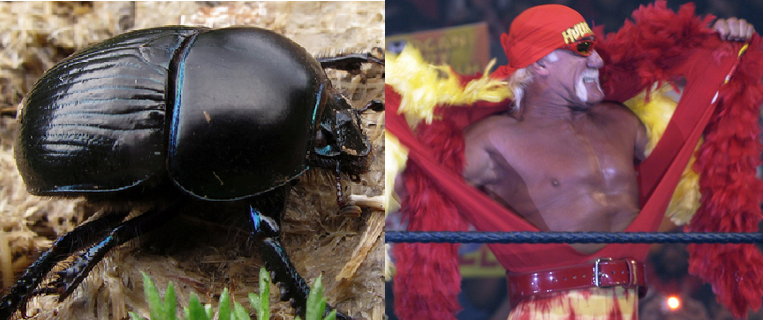
Who says science is boring? In this brand-new series, we cater amazing science stories to a Gen Y audience. Welcome to "Pop Science," a place where facts and GIFs collide.
So, dung beetles—those bowel movement-lovin' brutes—come in thousands of species; the Scarabaeinae variety alone is comprised of 5,000 different varieties of poo-feasting insects.
Dung beetles are also super laid-back. They're not like, "Um, I need the teeth-chattering cold or blistering heat to survive so back the fuck off"—they live in a diverse swathe of habitats including everything from grasslands and forest to farmland and desert. (You can find these anal aficionados on every damn continent except Antarctica.)
Dung beetles collect dung from both herbivores and omnivores, subsisting entirely on poop, deriving all necessary nutrients from their precious brown balls; rumor has it they prefer the hot loads of herbivores, however. Maybe it's less stinky. Or more roll-able.
Dung beetles can gather up snow-ball sized shit-balls that often weigh 10 times their body weight. (The male onthophagus taurus is the enviable beefcake among the beetles; scientists have seen them pull 1,141 times their own body weight, which is the the equivalent of an average person—not dead high on PCP—pulling six double-decker buses full of people.)
Once our fecal friends have rolled up a sufficient-sized ball for their noshing pleasure, they have to get the hell out of dodge because other dung beetles will begin vying for their load and attempt to steal it away. Understandable; it looks and smells so delicious. Like a turd-soaked Thanksgiving.
And this is where things get interesting. About 10 years ago, Professor Marcus Byrne from Wits University first discovered that dung beetles use the sun, the moon and polarized light to help determine their orientation. When scientists strapped the bugs with light-blocking cardboard caps, they discovered that the beetles then ceased to know where the hell they were going. Wilder still? The beetles also climb atop their poo-balls and bounce about in a kind of "dance" to locate the best light source.
Wits has taken his research one step further and determined that in the absence of moonlight, dung beetles can use the Milky Way to, well, find their way, making them the only known insect on earth to navigate using the galaxy. Although their eyes are decidedly too weak to distinguish between individual constellations, the theory goes:
"Even on clear moonless nights, many beetles still manage to orientate along straight paths. This led us to hypothesize that dung beetles exploit the starry sky for orientation, a feat that has, to our knowledge, never been demonstrated in an insect. Here, we show that dung beetles transport their dung balls along straight paths under a starlit sky but lose this ability under overcast conditions. In a planetarium, the beetles orientate equally well when rolling under a full starlit sky as when only the Milky Way is present." —Dung Beetles Use the Milky Way for Orientation
I know, that last bit was a doozy.
But wait! Before you go. One last wild fact:
In addition to feasting on and rolling about their fecal splendor, dung beetles also use them to mate and protect their offspring. A male and female roll along their ball until they find a nice soft spot in the ground where they then bury it and get. it. on. Then one of the loving parents prepares the "brooding ball," the female then lays her eggs inside it—sleep tight darlings!—which provides an endless supply of poo Gerber for the larvae when they hatch.
Because dung beetles are such diligent buriers, it's estimated by the American Institute of Biological Sciences that dung beetles save the United States cattle industry an estimated $380 million a year through burying above-ground livestock feces.
Live by the poo, die by the poo.

